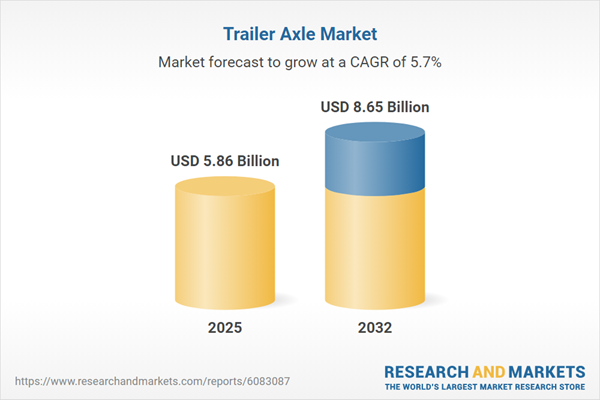Speak directly to the analyst to clarify any post sales queries you may have.
The trailer axle market is undergoing a significant transformation, driven by regulatory changes, technology adoption, and evolving customer demands. Senior industry leaders must navigate increased complexity to safeguard supply chain resilience and maintain a competitive edge in this rapidly changing landscape.
Market Snapshot: Trailer Axle Market Growth and Outlook
The trailer axle market grew from USD 5.56 billion in 2024 to USD 5.86 billion in 2025 and is anticipated to maintain a 5.66% CAGR, reaching USD 8.65 billion by 2032. This growth is underpinned by advancements in lightweight materials, the adoption of digital monitoring systems, and evolving global trade environments. Industry players contend with shifting trade policies, heightened demand for supply chain agility, and rising expectations for safety and efficiency.
Scope & Segmentation
This report offers an in-depth analysis, providing strategic insights across the full spectrum of the trailer axle sector. Key segments and their relevance include:
- Axle Configurations: Single, tandem, and tridem axles address different load requirements from light-duty to heavy-haul applications.
- Type: Drop, spring, straight, and torsion axles support diverse usage scenarios with tailored performance characteristics.
- Material: Steel for traditional durability and aluminum for lightweight, fuel-efficient solutions.
- Suspension Type: Air, multi leaf spring, and parabolic spring designs adapt to operational and comfort needs.
- Capacity: Options ranging from 2,000 lb to 15,000 lb suit commercial, recreational, and utility requirements.
- Distribution Channel: Both offline dealerships and online outlets such as brand websites and e-commerce platforms broaden market reach.
- Application: Covers commercial trailers, recreational trailers, semi trailers (including dry van, flatbed, refrigerated), and utility trailers.
- Sales Channel: Aftermarket and OEM pathways influence customer access and retention strategies.
- Geographic Regions: Comprehensive coverage across Americas, EMEA, and Asia-Pacific, with segmentation at country and sub-region levels.
- Industry Participants: Profiles leading players such as ZF Friedrichshafen AG, Schmitz Cargobull AG, Tata Motors Limited, SAF-HOLLAND GmbH, Hendrickson Holdings, L.L.C., Dexko Global, Inc., and others.
Key Takeaways for Senior Decision-Makers
- Material and design innovations are enabling lighter, more durable trailer axles that optimize load efficiency and reduce operational costs.
- Technology adoption, including telematics and predictive analytics, is establishing new standards for axle performance and real-time monitoring.
- Growing complexity in trade policy is shifting sourcing strategies and spurring greater localization or nearshoring efforts.
- Segmentation addresses flexible design and sales approaches to serve both high-volume commercial and niche specialized markets.
- OEM and aftermarket dynamics are evolving as digital channels gain prominence, expanding both direct and indirect market penetration opportunities.
- Regional variations in regulation, infrastructure, and logistics requirements highlight the importance of tailored product and partnership approaches.
Tariff Impact: Navigating Cost and Supply Chain Challenges
Revised tariffs introduced in the United States during 2025 have elevated production costs and added procurement pressures across the trailer axle market. Stakeholders are adapting by pursuing alternative sourcing, renegotiating contracts, and investing in domestic production or nearshoring. These responses aim to mitigate risks, improve supply chain resilience, and safeguard long-term competitive positioning in response to unpredictable global trade dynamics.
Methodology & Data Sources
This study applies a rigorous multi-stage research process. Primary data was gathered through expert interviews with engineers, supply chain executives, and regulatory consultants. These insights were cross-referenced with published industry reports, association releases, and regulatory documents. Proprietary quantitative analysis of production, shipping, and tariff data, validated by peer review from subject matter experts, supports the report’s robust accuracy and actionable findings.
Why This Report Matters for the Trailer Axle Market
- Enables effective alignment between product development and evolving regulatory, technological, and market requirements.
- Provides a structured basis for investment, procurement, and partnership decisions by identifying emerging risks and opportunities.
- Supports informed strategic planning to build supply chain resilience, boost operational efficiency, and sustain market leadership in a dynamic sector.
Conclusion
This report empowers senior leaders in the trailer axle sector with the clarity and data-backed insight needed for confident decision-making. Strategic imperatives identified here support competitiveness as the industry evolves in response to regulatory, technological, and supply chain shifts.
Table of Contents
3. Executive Summary
4. Market Overview
7. Cumulative Impact of Artificial Intelligence 2025
Companies Mentioned
The companies profiled in this Trailer Axle market report include:- ZF Friedrichshafen AG
- Schmitz Cargobull AG
- YORK TRANSPORT EQUIPMENT Pvt Ltd.
- Yantrik Agritech Private Limited
- Tata Motors Limited
- SAF-HOLLAND GmbH
- RSB Transmission Ltd.
- Rogers Axle & Spring Works Pty Ltd.
- Meritor, Inc. by Cummins Inc.
- Maxx Agro Industries Pvt. Ltd.
- Lippert Components, Inc.
- Kögel Trailer GmbH
- KK Metals Forging & Die Manufacturing Company
- K V Automotive Components
- JOST-Werke Deutschland GmbH
- Jiangling Group Shandong Huayue Vehicle Parts Co.,Ltd
- Hendrickson Holdings, L.L.C.
- Guangdong FUWA Group
- Foshan YongLiTai Axle Co., Ltd.
- Dexko Global, Inc.
- Blueswift Axles
- American Axle & Manufacturing, Inc.
- Alupart Sp. z o.o.
Table Information
| Report Attribute | Details |
|---|---|
| No. of Pages | 183 |
| Published | October 2025 |
| Forecast Period | 2025 - 2032 |
| Estimated Market Value ( USD | $ 5.86 Billion |
| Forecasted Market Value ( USD | $ 8.65 Billion |
| Compound Annual Growth Rate | 5.6% |
| Regions Covered | Global |
| No. of Companies Mentioned | 24 |









